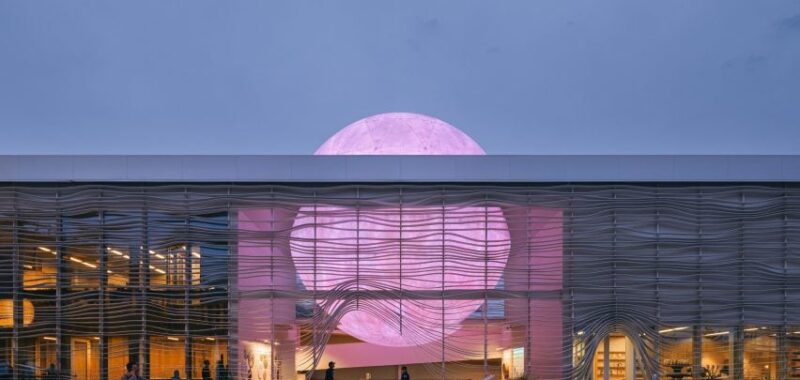
A suspended orb forms the centrepiece of the Netherlands Pavilion at Expo 2025 Osaka, designed by Amsterdam studio RAU Architects and design studio Tellart to reference the country’s connection to water and its use of renewable energy.
Spanning 425 metres in honour of 425 years of Dutch-Japanese trade relations, the pavilion is built from a steel structure and fronted with rippling slats that rise to reveal entrances at its front.
RAU Architects and Tellart chose water as a key focus for the pavilion in a nod to the Netherlands’ use of hydropower, as well as water being a “common ground” between the Netherlands and Japan.

Meanwhile, the 10.6-metre-wide orb that rises through the pavilion’s roof symbolises the sun and the concept of infinite energy. It also references the Tower of the Sun – a sculpture created by Japanese artist Tarō Okamoto for the Expo 1970 Osaka.
“The form of the Netherlands Pavilion at Expo 2025 Osaka is both symbolic and functional,” senior architect at RAU Architects Marta Roy told Dezeen.
“At its heart is a glowing sphere – a ‘man-made sun’ that represents clean, infinite energy on water.”

In line with many other pavilion’s at the Expo 2025 Osaka, the Netherlands Pavilion is designed for disassembly and reuse, with all elements built with visible joints and screws. It is also seismic resistant and intended to create playful patterns of light and shadow.
“Designed to meet strict natural disaster standards, the exterior feels crisp and monumental, animated by shifting light and shadows throughout the day,” Roy added. “[The pavilion] presents a striking contrast between its abstract, minimal exterior and its warm, tactile interior.”
The focus on material reuse is also visible across the interior, which is furnished with benches, tables and upholstery made from recycled materials.

Inside, the pavilion opens up to a central space with a mural and an installation called Water Basin, intended to reflect “the flow of nature” in response to the pavilion’s water-centred theme.
Above this, the suspended sphere contains a cinematic display that visitors can enter. Other displays include the Pledge Station – a collaborative art piece that visitors can contribute to before leaving the pavilion.
“The focus on water speaks about something we have in common with Japan as the Netherlands, our continuous struggle with water,” executive producer Ries Straver said.
“Water offers not only challenges but also opportunities and this is symbolised in the centre of the common ground space.”

Upon entry, visitors are each handed a glowing sphere, or Energy Orb, which allows them to engage with the pavilion’s interactive displays.
“The intention is to have our guests exit the pavilion with a sense of hope and clarity around the challenges we face as well as a sense of individual agency and communal energy to contribute to solving the challenges we collectively face,” Straver explained.

Other national pavilions at the event include the Czech Pavilion, which comprises a spiralling structure of timber and glass, and the energy-generating Japan Pavilion made from a demountable steel and timber structure.
The photography is by Zhu Yumeng unless otherwise stated.
Expo 2025 Osaka takes place in Osaka until 13 October 2025. For more fairs, events and talks in architecture and design, visit Dezeen Events Guide.
The post Glowing sphere protrudes from Netherlands Pavilion at Expo 2025 Osaka appeared first on Dezeen.

